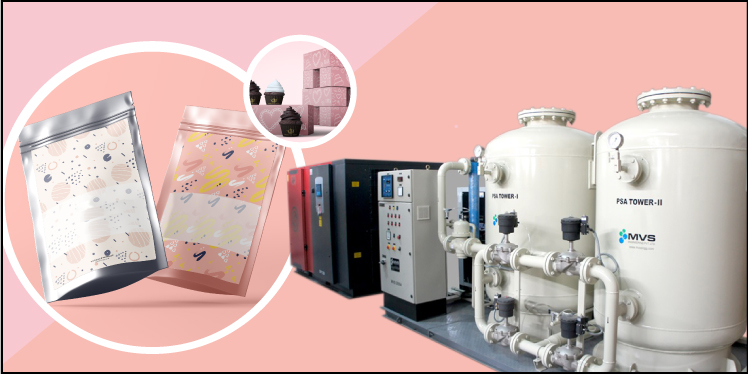Food packaging is a crucial component of the food industry. Only well-packed food items can satisfy customers. Food industry management needs to ensure that the taste and nutrition value of the food is preserved while packaging and delivering to customers. However, they also prefer low-cost packaging to keep the price of their food products affordable for common people. Hence, the use of nitrogen is highly popular among all food manufacturing and processing companies. The option of on-site nitrogen production can further make the packaging process easier.
Use of nitrogen in packing food items;
Nitrogen is introduced into food packs. Nitrogen gas creates pressure over the food particles and keeps the packs inflated. It prevents food particles from getting crushed while delivering to the market or customers. Though it is commonly seen in packets of chips, nitrogen can be used to pack all types of food products securely.
The inertness of nitrogen prevents oxidation and other chemical reactions in these food items. As nitrogen does not have any colour, odour, or taste, it does not cause any change in the physical properties of packed foods. Moreover, nitrogen replaces oxygen within packs, eliminating the risks of oxidation of food ingredients like fresh fish, meat, fruits, and vegetables. As nitrogen is a dry gas, it prevents the growth of bacteria, fungi, and other microbes that usually flourish in the humid air.
The use of nitrogen in food packaging can increase the shelf-life of packed foods to a large extent. Thus, customers can expect fresh food items in the same condition as they were when packed. However, most of these foods should be consumed very fast after the pack is cut open and the nitrogen is released back into the atmosphere.
Nitrogen is a light gas, and it does not increase the weight of these packed foods, making the delivery of foods easier. It does not exert too much pressure on packed food particles that could damage chips and other brittle foods. No other atmospheric gas is more suitable for packaging. Its physical and chemical properties mark it to be the best packaging gas over carbon dioxide and nitrous oxide, the other two probable options considered as packaging gases.
The nutrient value of foods can be preserved when packed with nitrogen. Thus, packaged foods remain healthy for consumers as they are intended to be. Food transportation to distant places may take a long time, for which packaging with nitrogen is the best solution to keep foods and beverages fresh and healthy till they reach customers.
Also Read
Use of nitrogen in wine and other beverages;
The major objective of nitrogen in the winemaking process is to remove and prevent oxygen from getting into touch with the wine, similar to how nitrogen is used in food packaging. Again, this is to prevent oxidation, which can degrade a wine, which is why food-grade nitrogen should be used. After a bottle of wine has been opened, oxidation is the reason why it is only drunk for a few days – the longer it is exposed to oxygen, the less drinkable (sourer or vinegar-like) it becomes.
Nitrogen is used in various methods to keep the wine from oxidizing. Nitrogen sparging is used to fight the presence of oxygen in wine that is formed during fermentation. Nitrogen sparging introduces microscopic bubbles into the wine that bind to oxygen and pull it out of the bottle.
Another application of nitrogen in the winemaking process is nitrogen flushing. The storage method involves moving wine between barrels and vessels (preventing sediment from forming). The hoses that transport the wine between vessels are cleansed with nitrogen to remove any oxygen that could oxidize the wine if it came into touch with it.
On-site production of nitrogen gas for the food and beverage industry;
Using cylinders for these industries is very inconvenient to use since they necessitate constant monitoring, changeovers, frequent ordering and deliveries. It is troublesome to carry nitrogen from the production site to where foods are packed. It also increases the cost of packaging if nitrogen is carried by pipelines or nitrogen cylinders are purchased at a high price. Therefore, on-site production of nitrogen can solve this problem for food and beverage industries and reduce their packaging expense. There is no need to place orders, wait for supplies, or deal with delays when nitrogen gas is generated on-site with a nitrogen generator. Because a facility with a nitrogen generator produces its own gas, it is never affected by changes in nitrogen prices.
Thus, reliable nitrogen gas producing company should be contacted to install an on-site nitrogen generator at the packaging site of a food processing company. MVS Nitrogen Generator has proved to be a perfect choice to provide a continuous supply of nitrogen for the food packaging and beverages industries. When the cost of Nitrogen generators and gas cylinders is compared, the on-site generator cost is just 20 to 40% of the cylinders.
Some food products, like beef, mutton, and pork, need a little amount of oxygen to retain their original colour and texture, for which a low percentage of nitrogen is needed for packing. On the other hand, beverages like coffee and beer need a very high percentage of nitrogen for packaging to ensure long shelf life. MVS on-site generators offer other benefits to the users, which is that the volume and purity of the gas can be generated as per the specific needs. Our nitrogen gas generators are developed using the latest technologies and designed with a modern design to deliver custom-designed plants to our customers.


